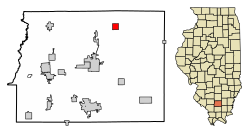Ewing, Illinois
Ewing, Illinois | |
|---|---|
 Location of Ewing in Franklin County, Illinois. | |
 Location of Illinois in the United States | |
| Coordinates: 38°5′24″N 88°51′13″W / 38.09000°N 88.85361°W | |
| Country | United States |
| State | Illinois |
| County | Franklin |
| Township | Ewing |
| Area | |
| • Total | 1.01 sq mi (2.62 km2) |
| • Land | 1.01 sq mi (2.61 km2) |
| • Water | 0.00 sq mi (0.00 km2) |
| Elevation | 471 ft (144 m) |
| Population (2010) | |
| • Total | 307 |
| • Estimate (2016)[2] | 302 |
| • Density | 299.31/sq mi (115.56/km2) |
| Time zone | UTC-6 (CST) |
| • Summer (DST) | UTC-5 (CDT) |
| ZIP Code(s) | 62836 |
| Area code | 618 |
| FIPS code | 17-24673 |
| Wikimedia Commons | Ewing, Illinois |
Ewing is a village in Franklin County, Illinois, United States. The population was 307 at the 2010 census.[3]
Geography
Ewing is located in northern Franklin County at 38°5′24″N 88°51′13″W / 38.09000°N 88.85361°W (38.089998, -88.853674).[4] It is 9 miles (14 km) northeast of Benton, the county seat.
According to the 2010 census, Ewing has a total area of 1.011 square miles (2.62 km2), of which 1.01 square miles (2.62 km2) (or 99.9%) is land and 0.001 square miles (0.00 km2) (or 0.1%) is water.[5]
Demographics
| Census | Pop. | Note | %± |
|---|---|---|---|
| 1880 | 170 | — | |
| 1890 | 290 | 70.6% | |
| 1900 | 419 | 44.5% | |
| 1910 | 317 | −24.3% | |
| 1920 | 341 | 7.6% | |
| 1930 | 342 | 0.3% | |
| 1940 | 339 | −0.9% | |
| 1950 | 330 | −2.7% | |
| 1960 | 250 | −24.2% | |
| 1970 | 220 | −12.0% | |
| 1980 | 321 | 45.9% | |
| 1990 | 264 | −17.8% | |
| 2000 | 310 | 17.4% | |
| 2010 | 307 | −1.0% | |
| 2016 (est.) | 302 | [2] | −1.6% |
| U.S. Decennial Census[6] | |||
As of the census[7] of 2000, there were 310 people, 121 households, and 86 families residing in the village. The population density was 305.8 people per square mile (118.5/km²). There were 136 housing units at an average density of 134.2 per square mile (52.0/km²). The racial makeup of the village was 100.00% White. Hispanic or Latino of any race were 1.29% of the population.
There were 121 households out of which 38.0% had children under the age of 18 living with them, 57.9% were married couples living together, 10.7% had a female householder with no husband present, and 28.1% were non-families. 26.4% of all households were made up of individuals and 14.9% had someone living alone who was 65 years of age or older. The average household size was 2.56 and the average family size was 3.10.
In the village, the population was spread out with 28.1% under the age of 18, 6.5% from 18 to 24, 26.8% from 25 to 44, 25.2% from 45 to 64, and 13.5% who were 65 years of age or older. The median age was 38 years. For every 100 females, there were 87.9 males. For every 100 females age 18 and over, there were 85.8 males.
The median income for a household in the village was $31,000, and the median income for a family was $41,042. Males had a median income of $36,250 versus $19,821 for females. The per capita income for the village was $14,917. About 6.8% of families and 9.3% of the population were below the poverty line, including 16.3% of those under the age of eighteen and none of those sixty five or over.
References
- ^ "2016 U.S. Gazetteer Files". United States Census Bureau. Retrieved Jun 29, 2017.
- ^ a b "Population and Housing Unit Estimates". Retrieved June 9, 2017.
- ^ "Geographic Identifiers: 2010 Census Summary File 1 (G001), Ewing village, Illinois". American FactFinder. U.S. Census Bureau. Retrieved May 4, 2016.
- ^ "US Gazetteer files: 2010, 2000, and 1990". United States Census Bureau. 2011-02-12. Retrieved 2011-04-23.
- ^ "G001 - Geographic Identifiers - 2010 Census Summary File 1". United States Census Bureau. Retrieved 2015-08-03.
- ^ "Census of Population and Housing". Census.gov. Archived from the original on May 12, 2015. Retrieved June 4, 2015.
{{cite web}}: Unknown parameter|deadurl=ignored (|url-status=suggested) (help) - ^ "American FactFinder". United States Census Bureau. Archived from the original on 2013-09-11. Retrieved 2008-01-31.
{{cite web}}: Unknown parameter|deadurl=ignored (|url-status=suggested) (help)
External links
- "The Town a College Created", article on the history of Ewing from Illinois History magazine, Illinois Periodicals Online (a project of the Northern Illinois University Libraries and the Illinois State Library)

